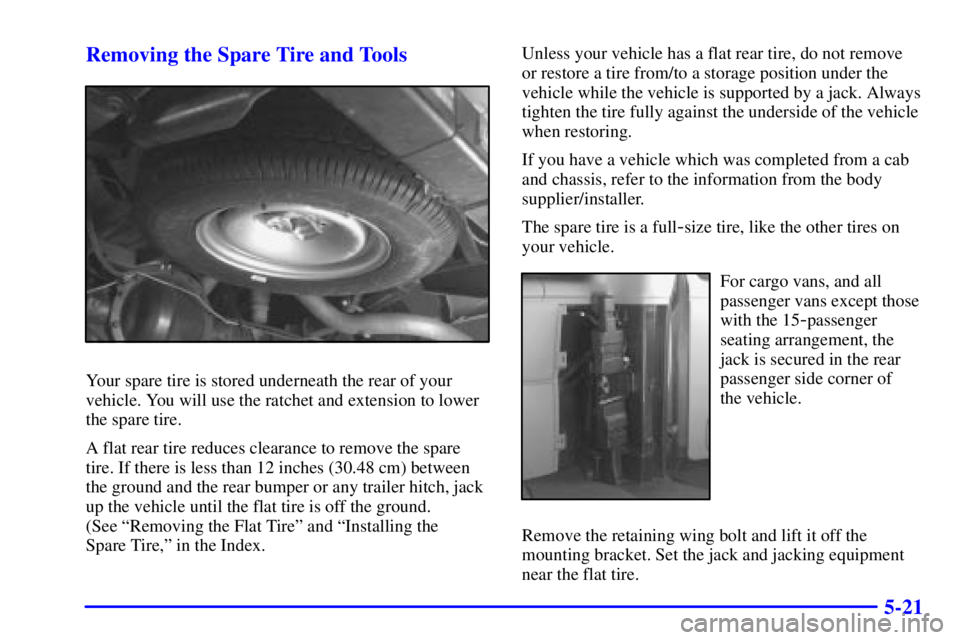Page 253 of 412

5-19
Engine Fan Noise
Your vehicle has a clutched engine cooling fan. When
the clutch is engaged, the fan spins faster to provide
more air to cool the engine. In most everyday driving
conditions, the fan is spinning slower and the clutch is
not fully engaged. This improves fuel economy and
reduces fan noise. Under heavy vehicle loading, trailer
towing and/or high outside temperatures, the fan speed
increases as the clutch more fully engages. So you
may hear an increase in fan noise. This is normal and
should not be mistaken as the transmission slipping or
making extra shifts. It is merely the cooling system
functioning properly. The fan will slow down when
additional cooling is not required and the clutch
partially disengages.
You may also hear this fan noise when you start
the engine. It will go away as the fan clutch
partially disengages.
If a Tire Goes Flat
It's unusual for a tire to ªblow outº while you're driving,
especially if you maintain your tires properly. If air goes
out of a tire, it's much more likely to leak out slowly.
But if you should ever have a ªblowout,º here are a few
tips about what to expect and what to do:
If a front tire fails, the flat tire will create a drag that
pulls the vehicle toward that side. Take your foot off the
accelerator pedal and grip the steering wheel firmly.
Steer to maintain lane position, and then gently brake to
a stop well out of the traffic lane.
A rear blowout, particularly on a curve, acts much like a
skid and may require the same correction you'd use in a
skid. In any rear blowout, remove your foot from the
accelerator pedal. Get the vehicle under control by
steering the way you want the vehicle to go. It may be
very bumpy and noisy, but you can still steer. Gently
brake to a stop
-- well off the road if possible.
If a tire goes flat, the next part shows how to use your
jacking equipment to change a flat tire safely.
Page 255 of 412

5-21 Removing the Spare Tire and Tools
Your spare tire is stored underneath the rear of your
vehicle. You will use the ratchet and extension to lower
the spare tire.
A flat rear tire reduces clearance to remove the spare
tire. If there is less than 12 inches (30.48 cm) between
the ground and the rear bumper or any trailer hitch, jack
up the vehicle until the flat tire is off the ground.
(See ªRemoving the Flat Tireº and ªInstalling the
Spare Tire,º in the Index.Unless your vehicle has a flat rear tire, do not remove
or restore a tire from/to a storage position under the
vehicle while the vehicle is supported by a jack. Always
tighten the tire fully against the underside of the vehicle
when restoring.
If you have a vehicle which was completed from a cab
and chassis, refer to the information from the body
supplier/installer.
The spare tire is a full
-size tire, like the other tires on
your vehicle.
For cargo vans, and all
passenger vans except those
with the 15
-passenger
seating arrangement, the
jack is secured in the rear
passenger side corner of
the vehicle.
Remove the retaining wing bolt and lift it off the
mounting bracket. Set the jack and jacking equipment
near the flat tire.
Page 256 of 412
5-22
For vans with the 15-passenger seating arrangement,
the jack is secured on the rear passenger side floor of
the vehicle.
Remove the retaining wing bolt and lift it out of the
mounting bracket. Set the jack and jacking equipment
near the flat tire.
The ratchet has a DOWN side and an UP side.
Attach the ratchet, with the DOWN side facing you, to
the extension. The extension has a socket end and a flat
chisel end.
Put the flat end of the extension on an angle through the
hole in the rear door frame, above the bumper. Be sure
the flat end connects into the hoist shaft.
Page 258 of 412
5-24
Jacking Tool Storage
A. Socket
B. Jack Handle
C. Ratchet
D. Jacking Tool Storage Box
E. Jack Handle ExtensionThe tools you'll be using include the jack (A), jack
handle extension (B), jack handle (C), socket (D) and
the ratchet (E).
Page 265 of 412
5-31
10. Tighten the
nuts firmly in
a crisscross
sequence as
shown. Turn
the wheel
wrench clockwise.
CAUTION:
Incorrect wheel nuts or improperly tightened
wheel nuts can cause the wheel to become loose
and even come off. This could lead to an accident.
Be sure to use the correct wheel nuts. If you have
to replace them, be sure to get new GM original
equipment wheel nuts.
Stop somewhere as soon as you can and have
the nuts tightened with a torque wrench to
140 lb
-ft (190 N´m).
NOTICE:
Improperly tightened wheel nuts can lead to
brake pulsation and rotor damage. To avoid
expensive brake repairs, evenly tighten the wheel
nuts in the proper sequence and to the proper
torque specification.
11. Put the wheel cover back on, or put the center cap
and plastic wheel nut caps back on. Remove any
wheel blocks.
Remember that the jack, jacking equipment and tire
must be properly stored in their original storage
position before you begin driving again. The next
part will show you how.
Page 268 of 412
5-34
5. Put the flat end of the extension on an angle through
the hole in the rear door frame, above the bumper.
6. Raise the tire fully against the underside of the
vehicle. Continue turning the ratchet/wheel wrench
until the tire is secure and the cable is tight. The
spare tire hoist cannot be overtightened.
7. Make sure the tire is stored securely. Push, pull, and
then try to rotate or turn the tire. If the tire moves,
use the ratchet/wheel wrench to tighten the cable.
You will hear two ªclicksº when the tire is up all
the way.
Return the jacking equipment to the proper location.
Secure the items and replace the jack cover.